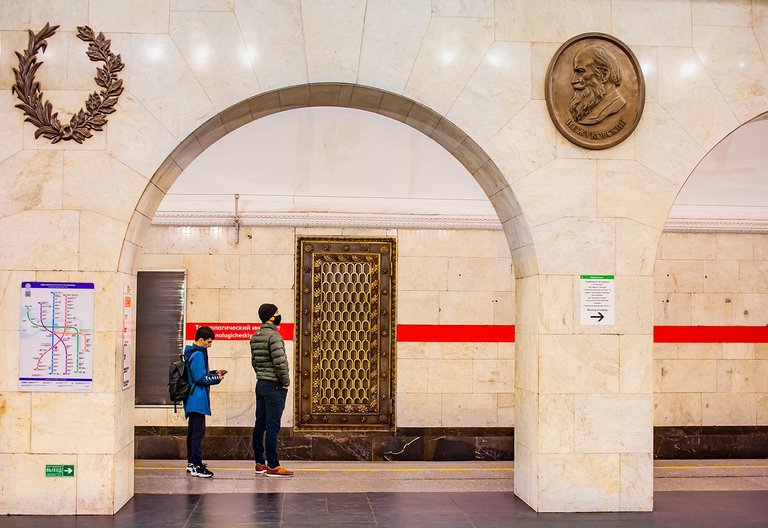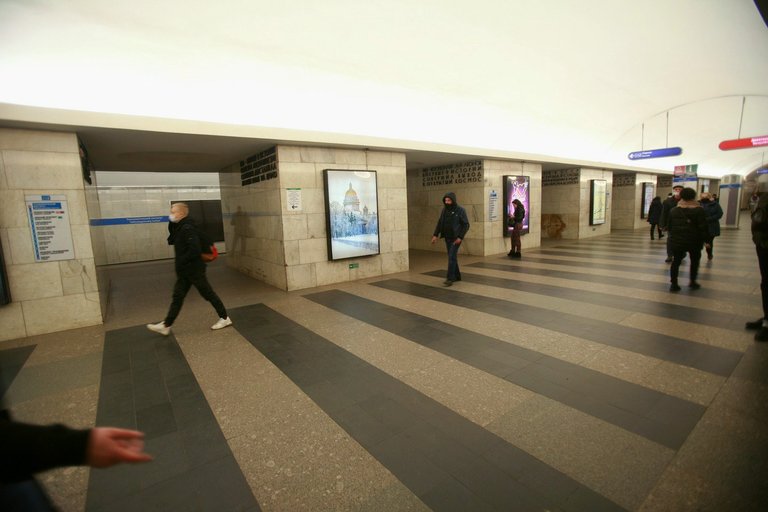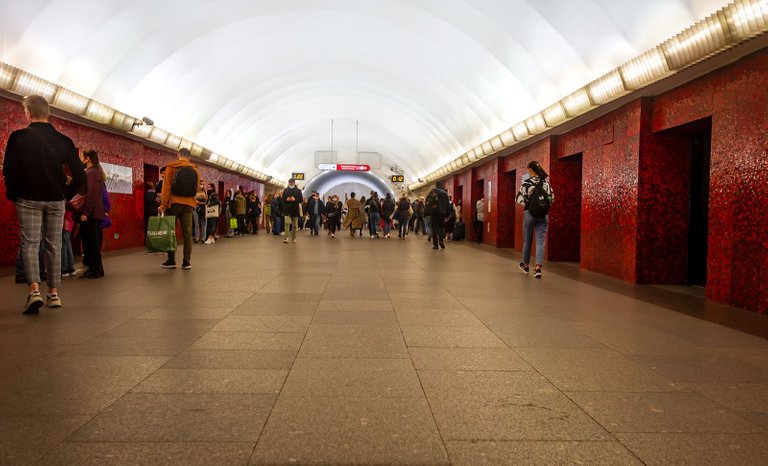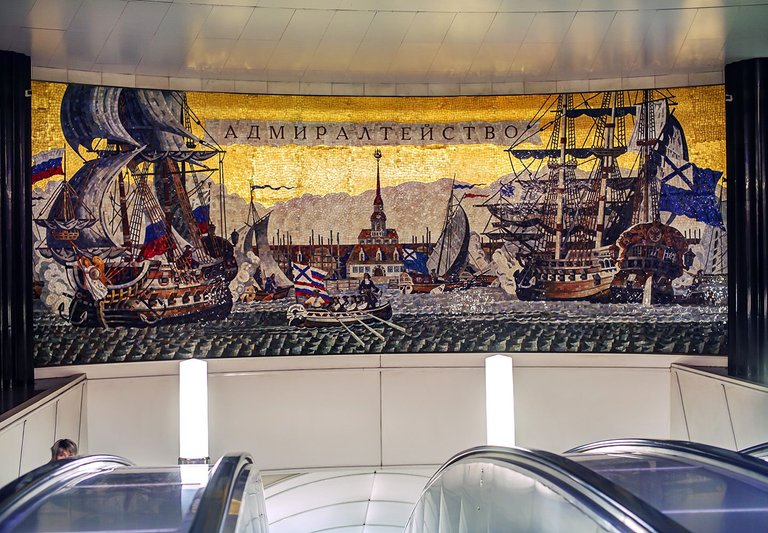My post goes for #WednesdayWalk challenge by @tattoodjay. Today I invite you to visit several tube stations at St.Petersburg, Russia. This will be just a short photo walk, without a long detailed excursion into the past, history of creation etc -- I'll leave that for a separate story :) Architecture and design connoisseurs, as well as lovers to travel to foreign countries without moving far from your monitor, warmly welcome! this post is exactly for you. If you plan a trip to St.Petersburg one day, I think the post also may be useful to you - add it to your bookmarks as "places of intrest".
Сегодняшний пост для фото-челленджа #WednesdayWalk @tattoodjay. Я предлагаю прогуляться по нескольким станциям метро в Санкт-Петербурге. Любители архитектуры, а также любители путешествовать по чужим странам не отходя далеко от монитора - добро пожаловать, это пост для вас! Вы не останетесь разочарованы. А если вы планируете поездку в СПб, добавляйте в закладки как "интересные места, которые стоит посетить". Это будет недолгая фотопрогулка, без детального экскурса в прошлое, в историю создания и т.д. - оставлю это для отдельной истории :)
Index to my previous posts about Russian Tube: Admiralty
I used to exclude tube from my list of photography subjects, but since I upgraded to a full frame camera and added a good wide-angle lens to my arsenal, now I can get some pretty good results, and started adding the images slowly to my archives. The Russian underground is a real underground museum, as my friend @melinda010100 once put it (her copyright is here))). Most of it was built in the middle of the twentieth century ... "Now they don't do things anymore like back then." (quote's source is unknown).
Раньше я исключал метро из списка интересующих меня фото-объектов, но с тех пор как я обновился на фулл-фрейм камеру и добавил в свой арсенал хороший широкоугольный объектив, теперь я могу получить кое-какие неплохие реультаты. Русское метро - самый настоящий подземный музей, как выразилась однажды мой друг Мелинда. Еще бы! Большая его часть была построена в середине ХХ века... "Теперь уже не делают вещи так, как делали тогда".
'Obvodniy channel' station is another station built after the 2000s, this is noticeable both in the avant-garde design, and in the new materials and technologies used. I will definitely dedicate a separate post to this station (someday) when I take more photos. Now I will note that the station design is based on photographs of old buildings - the entire length of the Obvodny Channel was "nailed" (this is a very long street that was an industrial zone in the 19th century). So, the walls of the station are a photoshopped "photo version" of what this street looked like at the beginning of the 20th century. Creative and unique! unique design solution and implementation.
'Обводный канал' - станция из новых, построенная в середине 2000-х, и это заметно и по авангардному дизайну, и по новых материалам и использованным технологиям. Я обязательно посвящу этой станции (когда-нибудь) отдельный пост, когда сделаю больше фотографий. Сейчас же замечу, что дизайн станции основан на фотографиях старинных зданий - "накрыта" вся длина Обводного канала (это очень длинная улица, бывшая в 19 веке промышленной зоной). То есть, стены станции - это офотошопленная "фотоверсия" того, как выглядела эта улица в начале ХХ века. Креативно и неповторимо. Уникальное дизайнерское решение и реализация.

'Mezhdunarodnaya' station looks splendid with all this massive bronze (fake gold) excesses.
Станция 'Международная' - достаточно новой постройки - смотрится роскошно. Много золота всегда ласкает взгляд... или нет?
«Technology institute» station is located in the center of the city. I come here quite often so I'm used to it and almost do not pay attention to its beauty and graceful forms.
Станция «Технологический институт» расположена в центре города. Я здесь так часто бываю, что привык и почти не обращаю внимания на ее красоту и изящные формы.
This way (crossing) station has a complex construction and actually consists of two different stations, which are given a different design. One of them (see photo above) is light and spacious, and the other is darker, squat, massive and "packed" (see below).
Эта пересадочная станция имеет сложную конструкцию и состоит на самом деле из двух станций, которым придан разный дизайн. Одна из них (выше) светлая и просторная, а другая более темная, приземистая, массивная и "уплотненная" (ниже).
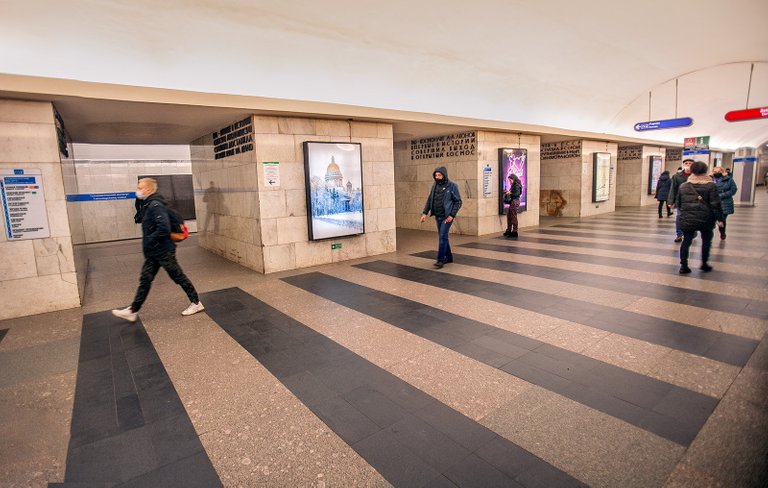
Below is original 'as camera shot it' without any digital processing and color correction.
Lighting actually may be quite a pain in the ass. I prefer better not to shoot in bad light conditions, simply skip it, as it obviously makes it hard to get good results. And underground with its artificial lighting, it's pointless to wait for any "sunny day" and better light -- it is always the same. Using tripod and flash is strictly prohibited (and penalted with a fine). By the way, until the mid-90s, even using a camera and shooting tube stations itself was prohibited too (they were considered as "secret objects, state secrets, etc" hehe) - so thanks for the laws became slightly relaxed, otherwise I could not show you any photos at all! All this I created as a comment to the photo above. Photographing some (poorly lit) stations is very difficult, if not impossible.
Освещение, на самом деле, это весьма болезненный вопрос, я не люблю фотографировать при плохом свете, это с очевидностью затрудняет получение хороших результатов. А в метро - все освещение искусственное, и бессмысленно там ждать "солнечного дня" и лучшего света, он всегда одинаковый. Использование штатива и вспышки в метро запрещены. кстати, до 90-х годов запрещено было и использование фотоаппарата, хехе - поэтому спасибо что законы слегка смягчились, иначе я не смог бы показать вам никаких фотографий вовсе). Все вышенаписанное я написал как комментарий к фото выше. Сфотографировать некоторые (плохо освещенные) станции очень трудно, и даже невозможно.

The platform of «Petrogradskaya» station. The main decor element is undulating ceramic tiles in a pleasant cream color. I haven't captured them properly yet, so I can't add them to the post and show you.
Перрон станции «Петроградская». Основной элемент декора - рельефные керамические плитки. Я пока не сфотографировал их должным образом, не могу добавить их в пост и показать вам.
The platform of the «Mayakovskaya» station. (Constructed back in 1966, this is one of the most sought after stations, a two lines junction in the city center). Please note exactly the same simple domed construction as the station above has, the only difference lies in the color scheme and finishing decoration: small red glazed tiles were used here.
Перрон станции «Маяковская». (Построенная в 1966 году, это одна из самых востребованных станций, узловая пересадочная станция в центре города). Обратите внимания - точно такая же конструкция, что и выше, вся разница заключается в цветовом решении и отделке: здесь использована мелкая красная глазированная плитка.

The station got its name in honor of the great Russian (and Soviet) poet, visionary, hooligan, futurist and avant-garde artist Vladimir Mayakovsky. His mosaic portrait and bronze sculpture also adorn this station.
Станция получила свое название в честь великого русского поэта, визионера, хулигана, футуриста и авангардиста Владимира Маяковского. Его портрет и скульптура также украшают эту станцию.

Above: the huge panel made from smalt, depicting the founder of the city, Emperor Peter 1 the Great and his nobles. Great place for a selfie, don't miss it :) The panel below decorates the entrance to the escalator at the same central Admiralteyskaya station.
Smalt is an artificial material, specially welded opaque multi-colored glass - has become widespread in the design of stations, sometimes it made the color decoration of entire stations (for example, as the Mayakovskaya station above), and most often plot panels and mosaics in the lobbies and key places.
Smalt is made by hand (to obtain fragments of a given shade and saturation). Mosaics are also assembled by hand. Therefore, each such panel or mosaic is a unique and very time-consuming work of art. I would be happy to tell a lot more interesting things about smalt, but this is beyond the scope of the post, perhaps I will write about it separately when I take more photos with mosaics).
I will only mention that the required volumes of smalt were supplied by a special workshop set up at the Academy of Arts in St. Petersburg. (Take a note to yourself: in addition to metro stations, St. Isaac's Cathedral and the Cathedral of the Savior on Spilled Blood are fully decorated with smalt mosaics).
Смальта - искусственный материал, специально сваренное непрозрачное разноцветное стекло - получила широкое распространение в дизайне станций, иногда ею выполнен цветовой декор целых станций (например, как станции "Маяковская" выше), а чаще всего из этого материала собирались сюжетные панно и мозаики в вестибюлях и ключевых местах.
Смальта изготавливается вручную (для получения фрагментов заданного оттенка и насыщенности). Собираются мозаики также вручную. Поэтому каждое такое панно или мозаика является уникальным и весьма трудоемким произведением искусства. Я с удовольствием мог бы рассказать о смальте еще много интересного, но это выходит за рамки поста, возможно, я напишу об этом отдельно когда сделаю больше фотографий с мозаиками).
Упомяну лишь, что требуемые объемы смальты поставляла особая мастерская, устроенная при Академии Художеств в Санкт-Петербурге. (Возьмите себе на заметку: кроме станций метро, полностью оформлены мозаиками из смальты Исаакиевский собор и собор Спаса-на-крови).
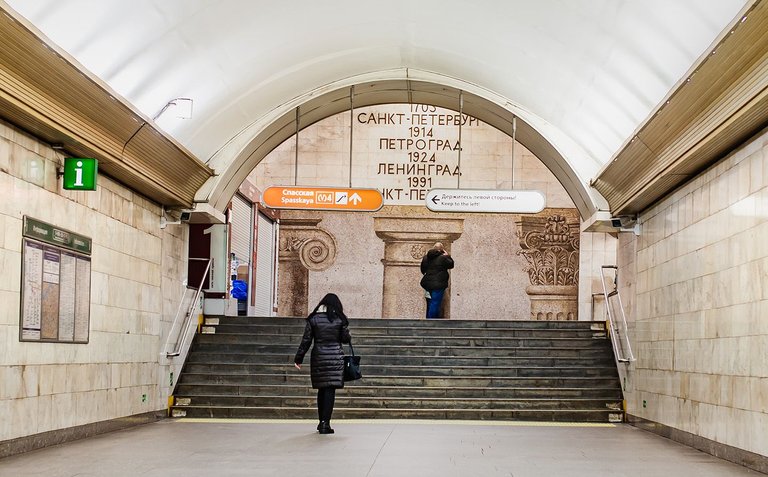
A good frame to finish our walk is this panno at Sadovaya station, which I consider to be a bit iconic: here are all four names that my city has had for more than 300 years of its history.
Хороший кадр, чтобы закончить нашу прогулку - панно на станции Садовая: здесь указаны все 4 названия, которые носил мой город за более чем 300-летнюю историю своего существования.
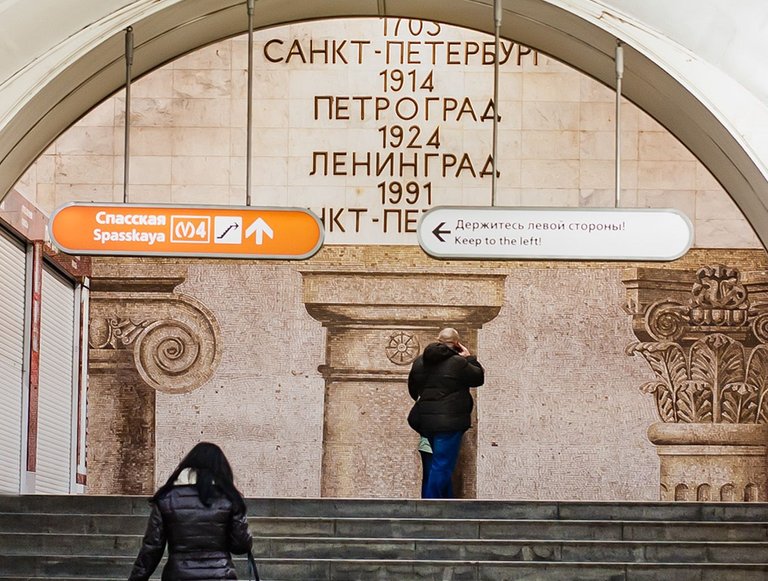
| location: | St.Petersburg, Russia | 2021-2022 | lamps light, no flash |
| camera/lens: | Canon 5D | 16-35mm 2.8L | raw-conv |
Thanks for walking with me, see you next time!
Надеюсь, вам было приятно прогуляться со мной по Петербургу!



